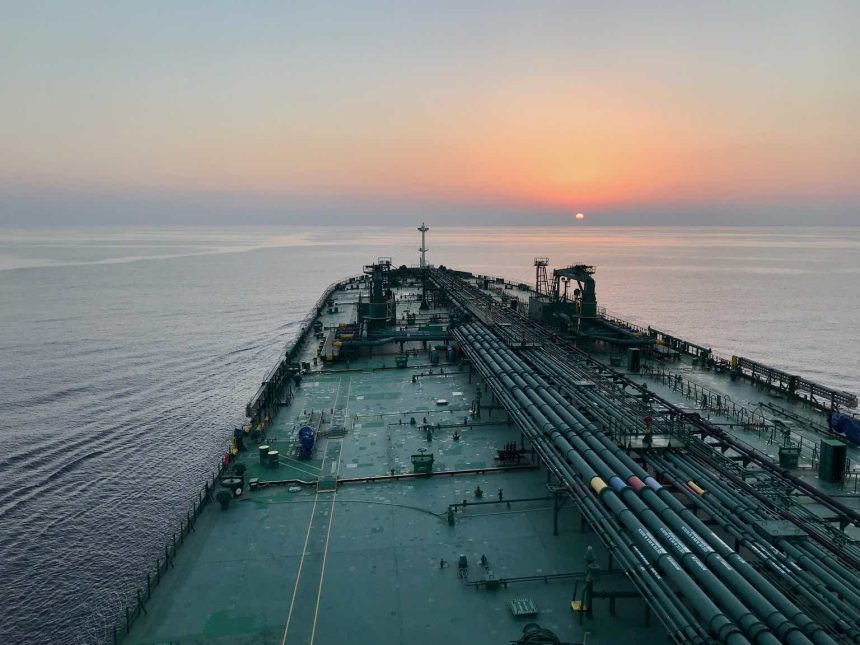Euronav (NYSE:EURN) has cemented its position as a leading entity in the shipping sector, consistently delivering impressive financial results, astute fleet augmentations, and a forward-thinking response to shifting global market trends. As one of the globe’s most significant owner/operators of VLCCs, EURN boasts a fleet with a DWT-adjusted average age dating back to 2016 and a median age of 7.5 years. This makes EURN’s fleet one of the most modern in the industry. Given this, we project that EURN will maintain its generous dividend payout approach for the coming quarters.
An often-overlooked factor in the shipping industry is the age of the average oil tanker. A significant proportion of the global fleet is aging, and there’s been a noticeable lack of new builds in recent years. This older average age, coupled with the dearth of new vessels, puts companies like EURN in a favorable position. They benefit from reduced competition and can command premium rates, especially given the increasing regulatory pressures and efficiency demands that older vessels struggle to meet.
We advocate for a portfolio mix that includes Oil Tanker companies like STNG, FRO, INSW, GASS, and EURN. This blend offers a compelling interplay of Price/Net Asset Value discounts and consistent dividend inflows. Our endorsement for EURN acquisition stems from the current momentum in the Oil Tanker sector, the advanced age of the global fleet, the strong pricing trends, both in rate terms and the tanker secondary market, and the advantages of a younger fleet. We set a Price Target for EURN at $20, aligning it with other industry frontrunners.
Recent Performance
In Q2 2023, Euronav reported a net profit of $161.8 million, mirroring the robust performance from Q1. With a leverage ratio at 47.5% and a fortified balance sheet, the company’s financial stability remains commendable, preparing it for even challenging tanker market conditions. Euronav’s cash and short-term investments are approximately $165 million, consistent with trends from recent years. We anticipate that any further cash generated will be directed towards rewarding investors and expanding the fleet, rather than merely augmenting the balance sheet through increased cash reserves or debt reduction. The company’s loan-to-value ratio is an impressive sector-leading 30%. The recent decision to elevate the payout ratio to 100% underscores its allegiance to shareholders, further exemplified by the $0.80 dividend declared in Q2. Cumulatively, the dividends declared in 2023 come to $2.63
In addition to high dividends, Euronav’s low debt has allowed them to invest in their fleet. The first half of 2023 saw the addition of three new Very Large Crude Carriers (VLCCs). The company also recently welcomed a new Suezmax vessel and plans to integrate four more into its fleet within the next year. While we would prefer to see capital be returned to investors instead of spent on new vessels at historically high valuations, we do understand that the companies present and future will be determined by these vessels.
While VLCC rates are remaining at their elevated levels, the past 9-10 months have seen a rise in oil demand, with Euronav benefiting significantly over that timeframe. China led the crude build up, but they have recently slowed down their large crude purchases in addition to this Saudi Arabia has continued their voluntary slow down. This slowdown in crude purchases and production has directly affected EURN and over the last few weeks shares have fallen roughly 15%.
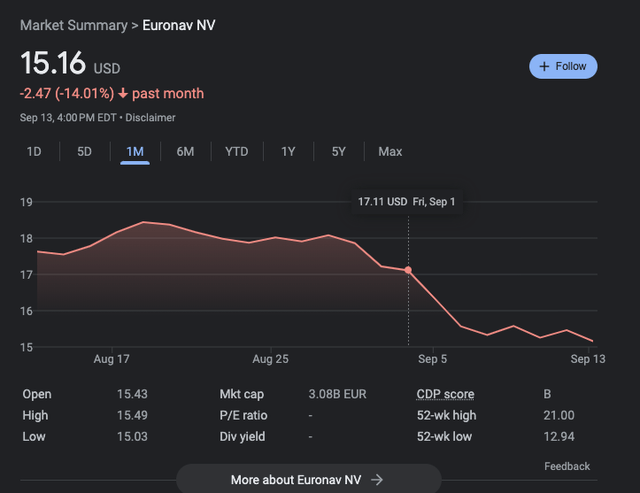
Google Stocks
Speculation around Iran’s potential re-entry into the oil market would be a game-changer for EURN. With Iran’s current production level at 1.5 million barrels per day, this re-entry could unlock a significant market segment for Euronav and would offset the voluntary Saudi Arabian cuts.
The Spot Market
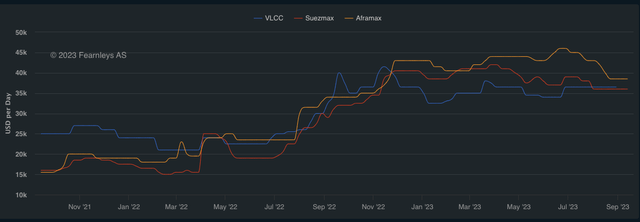
Fearnley’s
Despite some recent short-term headwinds VLCC rates have remained elevated with rates for VLCC’s hovering around $35k per day. It is predicted that there will be some weakening in Aframax and Suezmax rates relative to VLCCs but that weakness isn’t expected for a few months. With such a low debt-load EURN’s breakevens on their ships are also industry leading. EURN has a breakeven on Suezmax’s of $16,000 per day and $19,000 for VLCC’s. Some forward bookings for Q3 for EURN have been fixed at $45,000 per day which shows just how profitable this current rate environment is for EURN.
Valuation
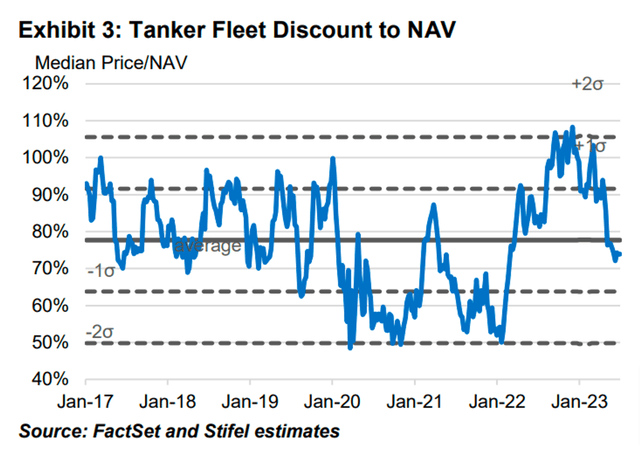
FactSet & Stifel
Since 2017, tanker fleets have typically traded at a discount to NAV with an average of ~79%. While profitability for fleet operations has varied widely over this time so has the valuation of the fleets.
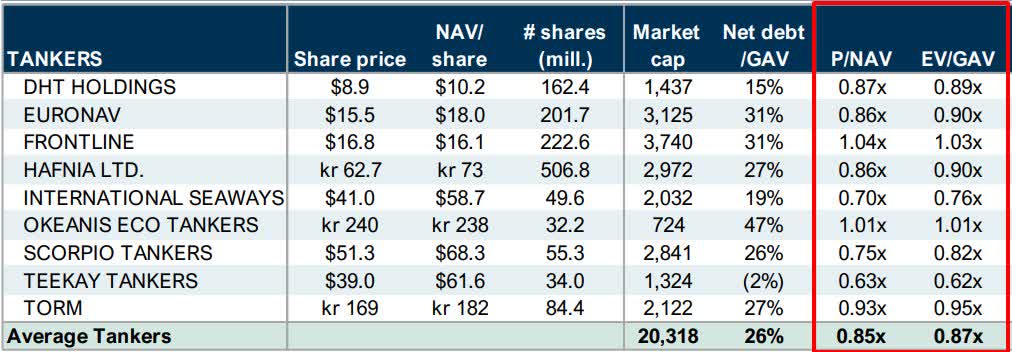
Pareto
Currently, the P/NAV for most of the major names in the space hovers around 0.85x and EURN sits right around that average with a P/NAV of 0.86x. This is roughly in line with the historical average of 0.79x. We believe that STNG, GASS, and INSW offer better NAV plays if you believe that these names should trade near the historical averages.
Conclusion
In our introductory remarks, we highlighted potential structural imbalances in the tanker market, which we anticipate will drive charter rates higher throughout 2023 and into 2024. Euronav is poised to capitalize on these elevated rates, and, unlike its counterparts, it’s not singularly focused on balance sheet enhancement. Their modern fleet offers a protective shield against the pressing need for new acquisitions—a challenge confronting competitors like Teekay Tankers (TNK). We are confident that EURN stands out as a company most inclined to consistently channel its earnings to shareholders. This conviction is reinforced by the management’s unwavering dedication to generous payout ratios. While the Oil Tanker and commodity sectors are not without risks, EURN’s substantial dividends, favorable spot rates and low daily breakevens offer a buffer against potential downturns. Euronav offers attractive dividends and presents a fair valuation complemented by promising growth prospects, given the right macroeconomic scenarios. We plan to have a ‘buy and hold’ strategy, as we foresee a conducive environment for tankers persisting for the foreseeable future.
Read the full article here


